
XL Simpósio Brasileiro de Telecomunicações e Processamento de Sinais
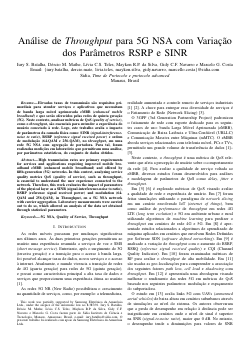
Análise de Throughput para 5G NSA com Variação dos Parâmetros RSRP e SINR
Iury Batalha, Dércio M. Mate, Maykon Renan Pereira da Silva, Marcello G. Costa, Lívia Christinie Teles, Gidy Florez Navarro
DOI: 10.14209/sbrt.2022.1570793703
Keywords: Throughput 5G RSRP NSA
Abstract
High transmission rates are primary requirements for services and applications requiring improved mobile broadband (EMBB - Enhanced Mobile Broadband) and offered by fifth-generation (5G) networks. In this context, analyzing service quality metrics (QoS - Quality of Service), such as Throughput, is essential to understand the user experience connected to the network. Therefore, this work evaluates the impact of parameters of the physical layer as a signal-interference-noise ratio (SINR- SIGNAL-to-interference-noise to ratio), power received by the reference signal (RSRP - Reference Signal Received Power) and Modulation (64QAM and 256QAM), in Throughput, on a 5G NSA network with carrier aggregation. Laboratory measurements were carried out to do so, which allowed an analysis of the set of data obtained through statistical parameters.Download
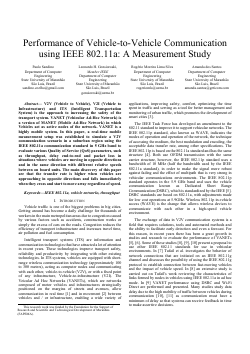
Performance of Vehicle-to-Vehicle Communication using IEEE 802.11a: A Measurement Study
Paulo Sandino, Leonardo Henrique Gonsioroski, Amanda Beatriz Cunha dos Santos, Rogerio Silva
DOI: 10.14209/sbrt.2022.1570800252
Keywords: IEEE 802.11a vehicle networks throughput
Abstract
V2V (Vehicle to Vehicle), V2I (Vehicle to Infrastructure) and ITS (Intelligent Transportation System) is the approach to increasing the safety of the transport system. VANET (Vehicular Ad-Hoc Network) is a version of MANET (Mobile Ad-Hoc Network) in which Vehicles act as active nodes of the network. VANET is a highly mobile system. In this paper, a real-time mobile measurement setup was established to simulate a V2V communication scenario in a suburban region using the IEEE 802.11a communication standard in 5 GHz band to evaluate various Quality of Service (QoS) parameters, such as throughput, delay end-to-end and packet loss in situations where vehicles are moving in opposite directions and in the same direction with different relative speeds between OBUs. The main discovery of this paper are that the transfer rate is higher when vehicles are approaching in opposite directions and falls immediately when they cross and start to move away regardless of speed.Download
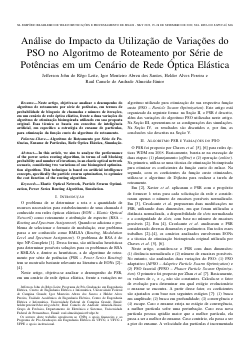
Análise do Impacto da Utilização de Variações do PSO no Algoritmo de Roteamento por Série de Potências em um Cenário de Rede Ótica Elástica
Jefferson Leite, Igor dos Santos, Helder A. Pereira, Raul C. Almeida Jr
DOI: 10.14209/sbrt.2022.1570800914
Keywords: Algoritmo de Roteamento por Série de Potências Enxame de Partículas Rede Ótica Elástica Simulação
Abstract
Neste artigo, objetiva-se analisar o desempenho do algoritmo de roteamento por série de potências, em termos de probabilidade de bloqueio de chamadas e número de iterações, em um cenário de rede ótica elástica, frente a duas variações do algoritmo de otimização bioinspirada utilizado em sua proposta original. Essa técnica se baseia em conceitos de inteligência artificial, em específico a estratégia de enxame de partículas, para otimização da função custo do algoritmo de roteamento.Download
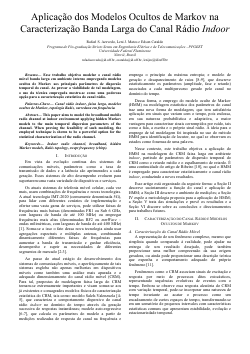
Aplicação dos Modelos Ocultos de Markov na Caracterização Banda Larga do Canal Rádio Indoor
Rafael Souza Azevedo, Leni Matos, Edson Cataldo
DOI: 10.14209/sbrt.2022.1570804884
Keywords: hidden Markov models Indoor radio channel Bakis topology
Abstract
This paper aims to model the broadband mobile radio channel at indoor environment applying hidden Markov models to the main temporal dispersion parameters of the channel. When proving the feasibility of such modeling, the employed technique is shown to be a powerful option for the statistical characterization of the radio channel.Download
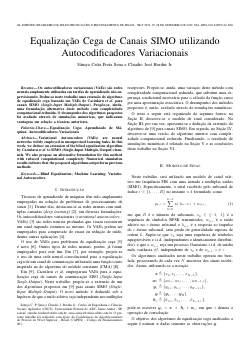
Equalização Cega de Canais SIMO utilizando Autocodificadores Variacionais
Samya C Sena, Claudio J. Bordin Jr.
DOI: 10.14209/sbrt.2022.1570805722
Keywords: Equalização Cega Aprendizado de Máquina Autocodificadores Variacionais
Abstract
Os autocodificadores variacionais (VAEs) são redes neurais amplamente utilizadas em tarefas de aprendizado não supervisionado. Deduz-se neste trabalho uma extensão do algoritmo de equalização cega baseado em VAEs de Caciularu et al. para canais SIMO (Single-Input Multiple-Output). Propõe-se, ainda, uma formulação alternativa deste método com complexidade computacional reduzida. O desempenho dos algoritmos propostos foi avaliado através de simulações numéricas, que indicaram vantagens em relação a técnicas anteriores.Download
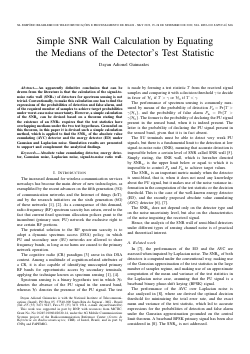
Simple SNR Wall Calculation by Equating the Medians of the Detector's Test Statistic
Dayan A. Guimarães
DOI: 10.14209/sbrt.2022.1570808158
Keywords: absolute value cumulating detector energy detector Laplacian noise signal-to-noise ratio wall
Abstract
An apparently definitive conclusion that can be drawn from the literature is that the calculation of the signal-to-noise ratio wall (SNRw) of detectors for spectrum sensing is not trivial. Conventionally, to make this calculation one has to find the expressions of the probabilities of detection and false alarm, and of the required number of samples to achieve target probabilities under worst-case noise uncertainty. However, a simple calculation of the SNRw can be devised based on a theorem stating that the existence of an SNRw requires that the test statistics have overlapping medians under the two test hypotheses. Grounded on this theorem, in this paper it is devised such a simple calculation method, which is applied to find the SNRw of the absolute value cumulating (AVC) detector and the energy detector (ED) under Gaussian and Laplacian noise. Simulation results are presented to support and complement the analytical findings.Download
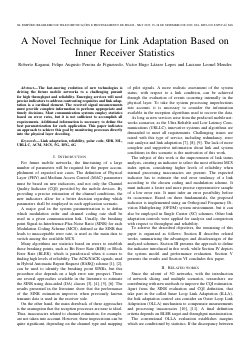
A Novel Technique for Link Adaptation Based on Inner Receiver Statistics
Roberto Kagami, Felipe Augusto Pereira de Figueiredo, Victor Hugo Lázaro Lopes, Luciano Leonel Mendes
DOI: 10.14209/sbrt.2022.1570808335
Keywords: link adaptation reliability ACM 6G
Abstract
The fast-moving evolution of new technologies is driving the future mobile networks to a challenging pursuit for high throughput and reliability. Emerging services will need precise indicators to address contrasting requisites and link adaptation is a cardinal element. The received signal measurements must provide complete information to perform appropriate and timely decisions. Most communication systems employ statistics based on error rates, but it is not sufficient to accomplish all requirements. Additional information is necessary to define the best parametrization for each application. This paper indicates an approach to achieve this goal by monitoring processes directly into the physical layer decoding.Download
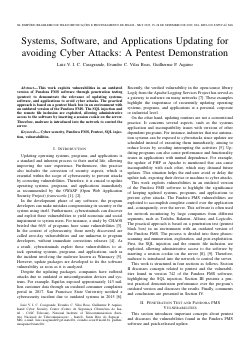
Systems, Software, and Applications Updating for avoiding Cyber Attacks: A Pentest Demonstration
Luiz Casagrande, Evandro Cesar Vilas Boas, Guilherme Pedro Aquino
DOI: 10.14209/sbrt.2022.1570808552
Keywords: Cyber security Pandora FMS Pentest SQL injection
Abstract
This work exploits vulnerabilities in an outdated version of Pandora FMS software through penetration testing (pentest) to demonstrate the relevance of updating systems, software, and applications to avoid cyber attacks. The practical approach is based on a pentest black box in an environment with an outdated version of the Pandora FMS. The SQL injection and the remote file inclusion are exploited, allowing administrative access to the software by inserting a session cookie on the server. Therefore, malware is introduced into the network to control the server.Download
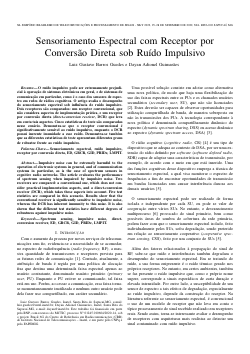
Sensoriamento Espectral com Receptor por Conversão Direta sob Ruído Impulsivo
Luiz Gustavo B. Guedes, Dayan A. Guimarães
DOI: 10.14209/sbrt.2022.1570808562
Keywords: Spectrum sensing impulsive noise direct-conversion receiver
Abstract
Impulsive noise can be extremely harmful to the operation of electronic systems in general, and of communication systems in particular, as is the case of spectrum sensors in cognitive radio networks. The article evaluates the performance of spectrum sensing when impaired by impulsive noise. Two receivers are compared: a conventional one, which does not consider practical implementation aspects, and a direct conversion receiver, which takes these aspects into account. Five test statistics are compared in this scenario. Results show that the conventional receiver is significantly sensitive to impulsive noise, whereas the implementation-oriented receiver has inherent immunity to this noise. It is also shown that the different test statistics have different degrees of robustness against impulsive noise.Download
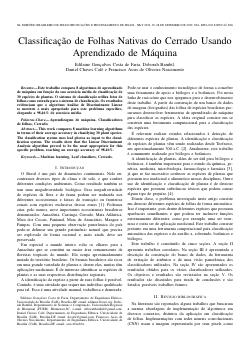
Classificação de Folhas Nativas do Cerrado Usando Aprendizado de Máquina
Edilaine Gonçalves Costa Faria, Deborah Bambil, Daniel Café, Francisco Assis de Oliveira Nascimento
DOI: 10.14209/sbrt.2022.1570810919
Keywords: Aprendizagem de máquina Classificadores de folhas Cerrado
Abstract
This work compares 8 machine learning algorithms in terms of their average accuracy in classifying 30 plant species. The classification system has a proprietary implementation and uses leaf photos as input to the classification system. The results show that the Linear Discriminant Analysis algorithm proved to be the most appropriate for this specific problem, reaching an average accuracy of 98.46%.Download